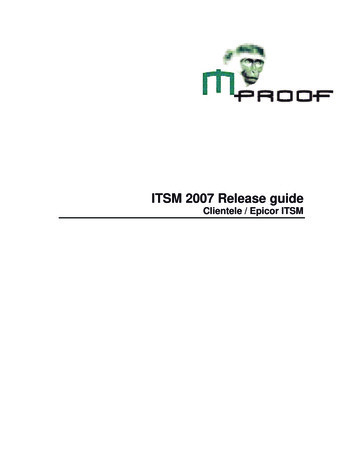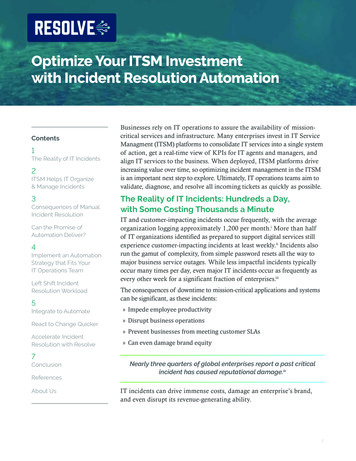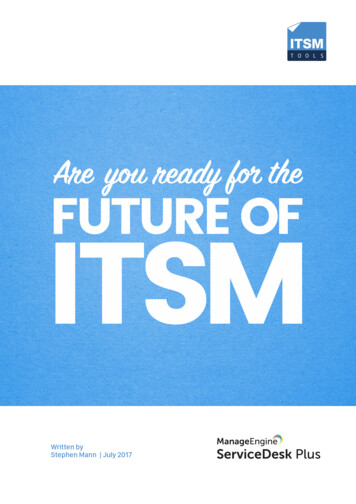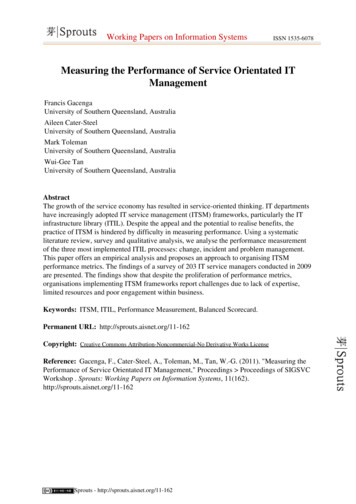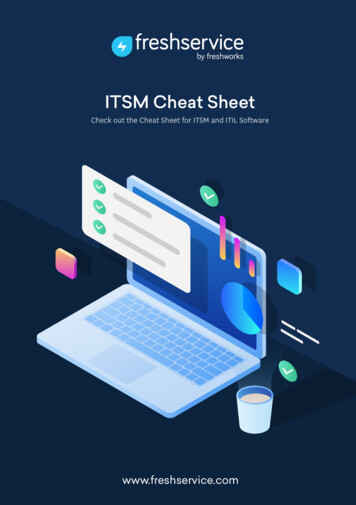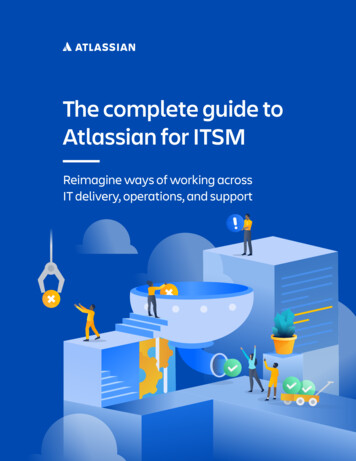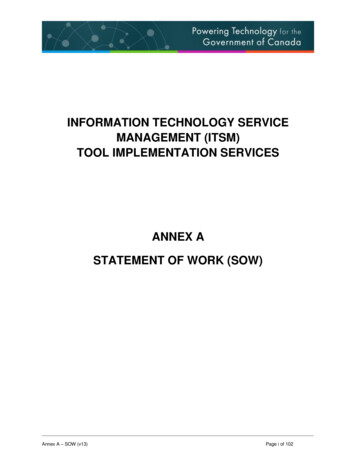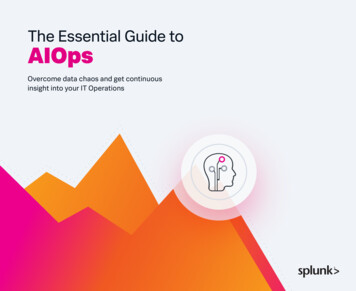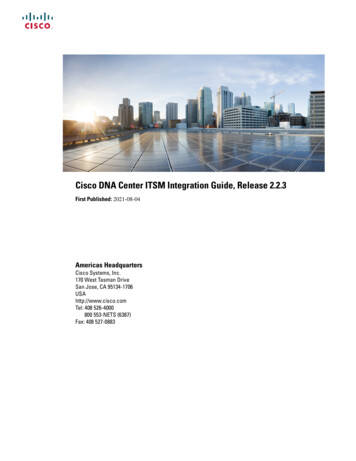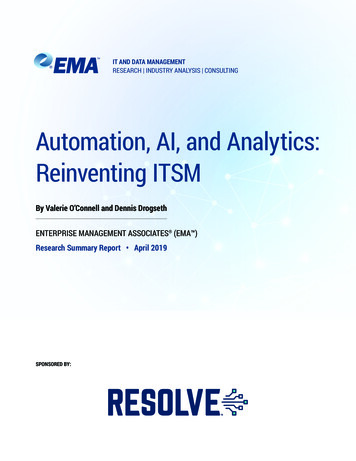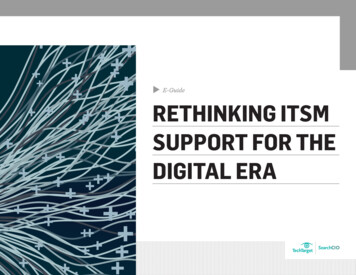
Transcription
E-GuideRETHINKING ITSMSUPPORT FOR THEDIGITAL ERASearchCIO
WITHOUT AN ITSM STRATEGY, THERE IS NO DIGITAL TRANSFORMATIONHomeThe digital roadmapdemands a new kindof ITSM supportWithout an ITSMstrategy, there is nodigital transformationIconsultant Harvey R.Koeppel examines why a fresh approachto IT service management (ITSM) isessential to not only remain competitive,but to ensure the survival of the IT department and even theenterprise. Additionally, expert Niel Nickolaisen explores how toleverage ITSM to sustain digital transformation.PA G E 2 O F 1 4n this e - guide ,SPONSORED BY
WITHOUT AN ITSM STRATEGY, THERE IS NO DIGITAL TRANSFORMATIONTHE DIGITAL ROADMAP DEMANDS A NEW KIND OF ITSMSUPPORTHomeThe digital roadmapdemands a new kindof ITSM supportWithout an ITSMstrategy, there is nodigital transformationHarvey R. KoeppelCustomers -- the ones outside and inside the enterprise -- expect IT to be fasterand less expensive. Perpetually. What’s newsworthy about that? To achievethese goals, many aspects of IT design, development, implementation andoperations are moving to the cloud. What’s newsworthy about that? Well, asmany of us know, the move to the cloud is easier said than done.Now add to this evolution --- or is it revolution? -- the additionaltransformative forces of social media, mobile technologies, Internet of Things(IoT), big data and analytics.Newsflash: CIOs and the departments they run need to transform themselvessimultaneously from the top down and from the bottom up, all while continuingto provide uninterrupted service at the same or better levels than today. Thechallenges we are facing can be compared to changing the wheels on a racecarwhile it is moving at 190 mph around the track.PA G E 3 O F 1 4SPONSORED BY
WITHOUT AN ITSM STRATEGY, THERE IS NO DIGITAL TRANSFORMATIONHomeThe digital roadmapdemands a new kindof ITSM supportWithout an ITSMstrategy, there is nodigital transformationA fresh approach to IT service management (ITSM) support is not onlyrequired to remain competitive -- it is essential to the survival of the ITdepartment and perhaps even of the enterprise.“Without continual growth and progress, such words as improvement,achievement, and success have no meaning.” -- Benjamin FranklinITSM IN A BATCH WORLDLife used to be, or appeared to be, so much simpler when all we needed to worryabout was organizing operating models into business processes and enablingbusiness processes via applications. The processes and programs that wedesigned, implemented and supported, for the most part, dictated what datawas needed where and when. We succeeded, sustained and competed upon ourability to drive process efficiencies and enhance applications that generallyresulted in improved productivity and reduced cost.Historically, our world went from batch to online -- aka interactive -processing. Much online processing was really still batch under the covers,initiated via front-end terminals. The online version of batch processingsimply ran more frequently and created efficiencies by returning reports inminutes or a few hours, compared with the quaint batch world that oftenPA G E 4 O F 1 4SPONSORED BY
WITHOUT AN ITSM STRATEGY, THERE IS NO DIGITAL TRANSFORMATIONHomeThe digital roadmapdemands a new kindof ITSM supportWithout an ITSMstrategy, there is nodigital transformationrequired users to wait for results that became available the next day. When truereal-time computing arrived on the scene, however, life got considerably moreinteresting. Finally, technology had created the ultimate Pavlovian businesstool -- I submit a request for information or to initiate an action (the stimulus)and get an almost immediate result (the response).The advent of real-time processing did much more than just turbocharge theeffective speed of business processes -- it provided enterprises with the meansto share and act upon common data across disparate platforms throughout andacross industries in an organized and controlled manner.SABRE TECHNOLOGY REDEFINES ITSM SUPPORTA great example of the business value created by real-time processing is SABRE(Semi-automated Business Research Environment). The technology wasdeveloped by American Airlines during the 1950s to manage the growing delugeof flight reservation requests more quickly, at lower cost and, in particular, toensure the same seat was not sold more than once. It was then syndicated bySabre Holdings across the airline and travel services industry.PA G E 5 O F 1 4SPONSORED BY
WITHOUT AN ITSM STRATEGY, THERE IS NO DIGITAL TRANSFORMATIONAt one point in its multidecade development history, under the visionaryleadership of CIO Max Hopper, American Airlines made more money fromSABRE licensing fees than it did from selling seats on airplanes.HomeThe digital roadmapdemands a new kindof ITSM supportWithout an ITSMstrategy, there is nodigital transformationITSM support in this context largely focused on: Supporting applications that automated and streamlined businessprocesses. Supporting the infrastructure -- LANs, WANs, data centers, databasesand desktops -- that enabled the applications and business processes. Supporting the staff -- managed types and finite numbers of userswith well-defined roles -- that enabled the applications and businessprocesses. Ensuring that system performance -- availability, response time, reliability and security -- met, in most cases, well-defined service-levelobjectives.“My dear, here we must run as fast as we can, just to stay in place. And ifyou wish to go anywhere you must run twice as fast as that.” -- Lewis Carroll,Alice in Wonderland, Queen of HeartsPA G E 6 O F 1 4SPONSORED BY
WITHOUT AN ITSM STRATEGY, THERE IS NO DIGITAL TRANSFORMATIOND STANDS FOR DIGITAL AND DISRUPTIONHomeThe digital roadmapdemands a new kindof ITSM supportWithout an ITSMstrategy, there is nodigital transformationNow, let’s factor in the “D-word,” digital, and take a look at what is happeningto our previously well-defined world of ITSM support:The confluence of digital technologies has caused major disruptions withinand across major industries. Uber (proper noun) started out as the name of acompany and is now a verb. When a company has been “Ubered,” it has essentiallybeen disintermediated by some combination of digital silicon life forms.Managing through disintermediation means changing your businessmodel, which ripples through changing your operating model, organization,business processes, applications, data requirements and so on.The impact of big data goes far beyond the need for more storage or betteranalytics. Spawned by the explosion of social media, for example, enterprisesknow much more about their customers and their competitors’ customers, andcustomers know much more about enterprises and their products and theircompetitors’ products. It is no longer only internal management and usersdemanding more and faster, it is also customers making the same demands.Enterprises need to step up or step aside.The impact of IoT goes far beyond building smart utility grids or bettertraffic management in congested cities. These are examples of a nascentPA G E 7 O F 1 4SPONSORED BY
WITHOUT AN ITSM STRATEGY, THERE IS NO DIGITAL TRANSFORMATIONHomeThe digital roadmapdemands a new kindof ITSM supportWithout an ITSMstrategy, there is nodigital transformationtechnology that will have dramatic effects on future businesses that we can onlybegin to imagine. To cite an example, there is already a fairly well-establishedconsensus that driverless vehicles will routinely populate our roads withinthe next few years. Presumably, this will mean fewer accidents, and safety issurely a good thing. What will all this good safety mean to the economics of anthe auto insurance industry? Or for that matter, on the automobile industry,which makes more money on repairs than it does on sales? Uh-oh.The impact of mobile technologies goes far beyond phones, tablets andsmart watches that can tell you when you have walked enough steps to declareyourself physically fit. Nanoscale devices, which are routinely being worn ordirectly implanted into our bloodstreams and major organs, can detect andeither report or repair, in real-time, defects that will make us significantlyhealthier and more likely to live longer lives. Living longer and stronger is surelya good thing. We can only hope that some yet-to-be-conceived technology willallow these healthy “old” people to remain active and productive in their everincreasing number of golden -- maybe platinum -- years. And what will all thisvitality and longevity mean to the economics of the health insurance industry?And what about pension plans and retirement benefits? Uh-oh, again.PA G E 8 O F 1 4SPONSORED BY
WITHOUT AN ITSM STRATEGY, THERE IS NO DIGITAL TRANSFORMATIONHomeNeedless to say this exposition could likely fill a book or at least voluminouscontent well beyond the resources devoted to creating this humble post.Hopefully, I have at least provided enough color and real-world examples tostimulate some new thinking about ITSM support in the digital world.The digital roadmapdemands a new kindof ITSM supportWithout an ITSMstrategy, there is nodigital transformationPA G E 9 O F 1 4SPONSORED BY
WITHOUT AN ITSM STRATEGY, THERE IS NO DIGITAL TRANSFORMATIONWITHOUT AN ITSM STRATEGY, THERE IS NO DIGITALTRANSFORMATIONHomeThe digital roadmapdemands a new kindof ITSM supportWithout an ITSMstrategy, there is nodigital transformationNiel NickolaisenIn case you have not yet heard it from every IT vendor, every non-IT vendor,neighbor, friend and analyst, we are in the age of the digital transformation.This age means that we do mobile first (or mobile only?), everything is softwaredefined, 40% of the Fortune 100 will fail in the next five years or six months orsomething like that, IT (including the CIO) will soon report to a chief digitalofficer -- the new CDO will be 23 years old but with deep experience in Reddit.And, in case you have not yet heard, everything is now different.All right, I am being a bit facetious about the hype around the digitaltransformation. That said, things really are different. Technology has and ischanging the world. Everything moves at the pace of technology innovation, andthat pace is break-neck. Many of us (at least those not yet reporting to the new23-year-old CDO) are driving organizational innovation and so have a senseof the changes taking place. With all that is changing, it is easy for us to forgetabout the basics of IT -- the blocking and tackling that ensure that we deliverPA G E 1 0 O F 1 4SPONSORED BY
WITHOUT AN ITSM STRATEGY, THERE IS NO DIGITAL TRANSFORMATIONHomeThe digital roadmapdemands a new kindof ITSM supportWithout an ITSMstrategy, there is nodigital transformationoperational excellence. For me, that blocking and tackling is based on theprinciples of IT service management (ITSM). I have found that the better I amat service management, the better I will be at operational excellence, customersatisfaction and, more important, IT agility. Perhaps my personal example willdemonstrate how a solid ITSM strategy enables digital transformation.LEVERAGING ITSM STRATEGY TO SUSTAIN DIGITAL TRANSFORMATIONWe design, develop and support two SaaS products that our clients and theiremployees use. When I first inherited these products, they were overly complex,fragile and brittle. All by themselves, they broke several times a week. As youmight expect, it is difficult to focus on innovation and digital transformationwhen we are not good at basic delivery. My first priority had to be to make theseproducts solid, reliable and high-performing. I am happy to report that wehave accomplished those tasks. How did we pull that off ? ITSM. We defined aservice catalog and service levels and then used a quality incident response andresolution process to get to and resolve the root cause of our application issues.As we consistently applied our ITSM strategy to our products, performanceimproved and we were able to shift our efforts from firefighting to the proactivePA G E 1 1 O F 1 4SPONSORED BY
WITHOUT AN ITSM STRATEGY, THERE IS NO DIGITAL TRANSFORMATIONHomeThe digital roadmapdemands a new kindof ITSM supportWithout an ITSMstrategy, there is nodigital transformationinnovation of our products. And, as we made this shift, we retained our focuson our use of ITSM principles.As our product foundation improved, we started to seize and realizeopportunities to shorten our time to market. This led us to experiment with andstart to use agile software development methods and DevOps. We moved fromtwice-yearly product releases to monthly releases and now to weekly releases.Shrinking our release cycle has created significant value. Fixes, enhancementsand good old innovations get to our customers much faster. And, each releaseis smaller and therefore less complex and less risky. In order to pull this off, wehad to be really good at service definition, delivery and management. In otherwords, we had to have our ITSM act together.As we shorten our development cycles, we must shorten our incidentresponse and root cause analysis cycles. In our case, we use productionworthiness standards that define what we mean by a quality service. We meetweekly to review pending changes (including the week’s product release) andany open incidents (an open incident is one for which we have not yet identifiedthe root cause or implemented the counter measure). We focus our attentionon the process rather than the specific incident. If the last release introduceda software bug, we ask ourselves how we need to change our softwarePA G E 1 2 O F 1 4SPONSORED BY
WITHOUT AN ITSM STRATEGY, THERE IS NO DIGITAL TRANSFORMATIONHomeThe digital roadmapdemands a new kindof ITSM supportdevelopment processes in order to reduce the likelihood of releasing a bug. Thisshort, weekly cycle closes the time gap between incident and counter measure.And, short feedback loops are critical to improved performance.Digital transformation depends on quality and agility. I have a strongopinion -- formed over years of success and failure -- that the CIO’s ITSMstrategy is the key to both quality and agility.Without an ITSMstrategy, there is nodigital transformationPA G E 1 3 O F 1 4SPONSORED BY
WITHOUT AN ITSM STRATEGY, THERE IS NO DIGITAL TRANSFORMATIONFREE RESOURCES FOR TECHNOLOGY PROFESSIONALSHomeThe digital roadmapdemands a new kindof ITSM supportWithout an ITSMstrategy, there is nodigital transformationTechTarget publishes targeted technology media that addressyour need for information and resources for researchingproducts, developing strategy and making cost-effectivepurchase decisions. Our network of technology-specific Websites gives you access to industry experts, independent contentand analysis and the Web’s largest library of vendor-providedwhite papers, webcasts, podcasts, videos, virtual trade shows,research reports and more —drawing on the rich R&D resources of technology providers toaddress market trends, challenges and solutions. Our live events and virtual seminars giveyou access to vendor neutral, expert commentary and advice on the issues and challengesyou face daily. Our social community IT Knowledge Exchange allows you to share real worldinformation in real time with peers and experts.WHAT MAKES TECHTARGET UNIQUE?TechTarget is squarely focused on the enterprise IT space. Our team of editors and networkof industry experts provide the richest, most relevant content to IT professionals andmanagement. We leverage the immediacy of the Web, the networking and face-to-faceopportunities of events and virtual events, and the ability to interact with peers—all tocreate compelling and actionable information for enterprise IT professionals across allindustries and markets.PA G E 1 4 O F 1 4SPONSORED BY
of ITSM support Without an ITSM strategy, there is no digital transforma-tion. WITHOT A ITSM STATEGY, THEE IS O IGITA TASFOMATIO. n this e-guide, . (at least those not yet reporting to the new 23-year-old CDO) are driving organizational innovation and so have a sense of the changes taking place. With all that is changing, it is easy for us to .
